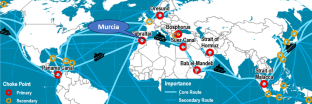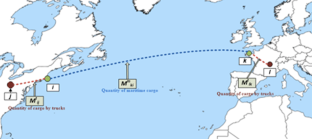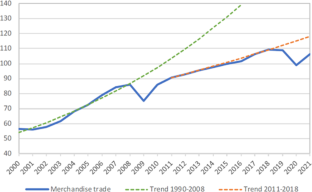Abstract
We study intercontinental supply chains, with each continent having cargo hubs competing with location advantages and efficiency. We estimate and compare the sequence of flows between nodes using gravity models (GM). However, in studying the global location advantages of a port, these sequences should be well connected, a case not treated in the literature. We combine a multi-echelon supply chain approach with well-combined sequential gravity mechanisms where the time distances, waiting time in the ports, and GDP of origin and destination play a central role. Our approach represents a novel approach to the intercontinental supply chain design and evaluation. In GM, the time distance variable is a proxy for transportation cost and enables us to jointly estimate transportation and waiting time influences. The time distance better measures impact of a pollutant on the environment of a supply chain than the geographic distance. With the time distances as a major factor in the GM formula, the GM is embedded in three consecutive sections of the intercontinental supply chain formulation and strongly connects them. The approach enables us to estimate the advantages of opening a new port in Cartagena, as the main port of Murcia, Spain. This investment would reduce the waiting lines of ships in other ports of the northern Mediterranean Sea and attract more containerized vessels to the area. Using sequential gravity mechanisms, we find that the Cartagena area in Murcia was appealing enough to begin investing in a new port, which could be among the top 100 international ports.

Source: Shipping density data adapted from National Center for Ecological Analysis and Synthesis, A Global Map of Human Impacts to Marine Ecosystems & Rodrigues (2020). https://www.google.com/url?sa=t&rct=j&q=&esrc=s&source=web&cd=&ved=2ahUKEwib46m9sbSDAxW7RKQEHTl-CAsQFnoECBAQAQ&url=https%3A%2F%2Ftransportgeography.org%2Fwp-content%2Fuploads%2FMap-Domains-Maritime-Circulation.pdf&usg=AOvVaw0BEayfeyZsrIrRy_wThx14&opi=89978449

Source: Elaborated by authors
Similar content being viewed by others
References
Anderson JE, van Wincoop E (2004) Trade costs. J Econ Lit 42(3):691–751
Beckman J, Burfisher M, Mitchell L, Arita S (2021) Hidden obstacles to trade: the case of the EU’s Ban on beef hormones. J Policy Model 43(6):1332–1343
Bensassi S, Marquez-Ramos L, Martinez-Zarzoso I, Suarez-Burguet C (2015) Relationship between logistics infrastructure and trade: evidence from Spanish regional exports. Transp Res Part A Policy Pract 72(C):47–61
Blonigen BA, Wilson WW (2008) Port efficiency and trade flows. Rev Int Econ 16(1):21–36
Bogataj L, Bogataj M (2007) The study of optimal additional investments in capacities for reduction of delays in value chain. Int J Prod Econ 108:281–290
Bogataj M, Usenik J (2005) Fuzzy approach to the spatial games in the total market area. Int J Prod Econ 93–94:493–503
Bogataj M, Grubbström RW, Bogataj L (2011) Efficient location of industrial activity cells in a global supply chain. Int J Prod Econ 133(1):243–250
Bogataj D, Aver B, Bogataj M (2016) Supply chain risk at simultaneous robust perturbations. Int J Prod Econ 181:68–78
Bottasso A, Conti MPC, Ferrari C, Tei A (2018) Port infrastructures and trade: empirical evidence from Brazil. Transp Res Part A Policy Pract 107:126–139
Bougheas S, Demetriades PO, Morgenroth ELW (1999) Infrastructure, transport costs and trade. J Int Econ 47(1):169–189
Chan EMH, Ho DCK, Tsang CW (2021) Estimating United States-Asia clothing trade: multiple regression vs artificial neural networks. J Asian Financ Econ Bus 8(7):403–411
Chang SM, Huang YY, Shang KC, Chiang WT (2020) Impacts of regional integration and maritime transport on trade: with special reference to RCEP. Marit Bus Rev 5(2):143–158
Chang Y-T, Jo A, Choi K-S, Lee S (2021) Port efficiency and international trade in China. Transp A Transp Sci 17(4):801–823
Cheng GX, Wilmot CG, Baker EJ (2011) Dynamic gravity model for hurricane evacuation planning. Transp Res Rec 2234:125–134
Chhetri P, Nkhoma M, Peszynski K, Chhetri A, Lee PTW (2018) Global logistics city concept: a cluster-led strategy under the belt and road initiative. Marit Policy Manag 45:319–335
Clark X, Dollar D, Micco A (2004a) Port efficiency, maritime transport costs and bilateral trade. J Dev Econ 75(2):417–450
Clark X, Dollar D, Micco A (2004b) Port efficiency. Maritime transport costs and bilateral trade. NBER Working Paper Series. Working Paper 10353. Available at: http://www.nber.org/papers/w1035
da Silva MAV, D’Agosto MD (2013) A model to estimate the origin–destination matrix for soybean exportation in Brazil. J Transp Geogr 26:97–107
Das SK, Roy SK, Weber GW (2020) Heuristic approaches for solid transportation-p-facility location problem. CEJOR 28(3):939–961
Dong M, Li Y, Xu X, Zha Y (2022) Practical accessibility evaluation method for port-centric coal transportation chains: considering the environment and operational adaptability. Sustainability 14(18):11619
Drezner T, O’Kelly M, Drezner Z (2023) Multipurpose shopping trips and location. Ann Oper Res 321(1–2):191–208
Drobne S, Bogataj M (2012) A method to define the number of functional regions: an application to NUTS 2 and NUTS 3 levels in Slovenia. Geodetski Vestnik 56(1):105–150
Drobne S, Bogataj M (2013a) Evaluating functional regions for servicing the elderly. In: SOR '13 proceedings. 12th International symposium on operational research in Slovenia. Ljubljana: SDI-SOR. pp 331–336
Drobne S, Bogataj M (2013b) Impact of population aging on migration to regional centres of Slovenija. In: SOR '13 proceedings. 12th international symposium on operational research in Slovenia. Ljubljana: SDI-SOR. pp 325–330
Ducruet C, Itoh H, Berli J (2020) Urban gravity in the global container shipping network. J Transp Geogr 85:102729
Fugazza M, Hoffmann J (2017) Liner shipping connectivity as determinant of trade. J Shipp Trade. https://doi.org/10.1186/s41072-017-0019-5
Gani A (2021) Achieving food security through live animal imports in the Gulf Cooperation Council countries. Br Food J 123(4):1397–1412
Gharehgozli AH, de Koster R, Jansen R (2017) Collaborative solutions for inter terminal transport. Int J Prod Res 55(21):6527–6546
Goh S, Lee K, Park JS, Choi MY (2012) Modification of the gravity model and application to the metropolitan Seoul subway system. Phys Rev E. https://doi.org/10.1103/PhysRevE.86.026102
Grossmand GM, Helpman E (2002) Integration versus outsourcing in industry equilibrium. Q J Econ 117:85–120
Gürel S, Shadmand A (2019) A heterogeneous fleet liner ship scheduling problem with port time uncertainty. CEJOR 27(4):1153–1175
Hacardiaux T, Tancrez JS (2020) Assessing the environmental benefits of horizontal cooperation using a location-inventory model. CEJOR 28(4):1363–1387
Helena HB (2015) Modified method of gravity model application for transatlantic air transportation. Neural Netw World 25(2):203–217. https://doi.org/10.14311/NNW.2015.25.011
Hu Y, Zhu D (2009) Empirical analysis of the worldwide maritime transportation network. Phys A 388(10):2061–2071
Janež P, Bogataj M, Drobne S (2016) Impact of the real estate taxation and municipal revenue on dynamics of internal migration: case study for City Municipal of Ljubljana. Geodetski Vestnik 60(4):644–684
Jung WS, Wang F, Stanley HE (2008) Gravity model in the Korean highway. EPL-Euro Phys Lett 81(4):4805–4820. https://doi.org/10.1209/0295-5075/81/48005
Kovačić D, Bogataj M (2017) Net present value evaluation of energy production and consumption in repeated reverse logistics. Technol Econ Dev Econ 23(6):877–894
Kundu T, Sheu J-B (2019) Analysing the effect of government policy intervention on cross-border freight transportation flows: the Belt and Road perspective. Transp A Transp Sci 15:1360–1381
Lee PTW, Hu ZH, Lee SJ, Choi KS, Shin SH (2018) Research trends and agenda on the Belt and Road (B&R) initiative with a focus on maritime transport. Marit Policy Manag 45:282–300
Limao N, Venables AJ (2001) Infrastructure, geographical disadvantage, transport costs and trade. The World Bank Econ Rev 15(3):451–479
Liu YT, Wang SG, Chen B (2018) Blue, green and grey water embodied in food supply chain in China. Clean Energy Clean Cities 152:287–292
Llano C, De la Mata T, Díaz-Lanchas J, Gallego N (2017) Transport-mode competition in intra-national trade: an empirical investigation for the Spanish case. Transp Res Part A Policy Pract 95:334–355
Matsumoto H (2004) International urban systems and air passenger and cargo flows: some calculations. J Air Transp Manag 10:241–249
Muñuzuri J, Cortés P, Onieva L, Guadix J (2010) Modelling peak-hour urban freight movements with limited data availability. Comput Ind Eng 59(1):34–44
Nordås HK, Piermartini R (2004) Infrastructure and trade. Staff Working Paper ERSD-2004–04. WTO - Economic Research and Analysis Division
Pagano AM, Light MK, Sánchez OV, Tapiero E (2012) Impact of the Panama Canal expansion on the Panamanian economy. Marit Policy Manag 39(7):705–722
Portugal-Perez A, Wilson JS (2012) Export performance and trade facilitation reform: hard and soft infrastructure. World Dev 40(7):1295–1307
Radelet S, Sachs JD (1998) Shipping costs. Manufactured exports, and economic growth. JDS Books Articles Media & Talks. Available at: https://www.jeffsachs.org/newspaper-articles/3bshe958re39r2ssm552dyxk8bg6em
Randrianarisoa LM, Gillen D (2022a) Reducing emissions in international transport: a supply chain perspective. Transp Res Part D-Transp Environ 102:103074
Randrianarisoa LM, Gillen D (2022b) Reducing emissions in international transport: a supply chain perspective. Transp Res Part D 102:103074
Reilly WJ (1929) Methods for the study of retail relationships. University of Texas, Texas
Reilly WJ (1931) The law of retail gravitation. Knickerbocker Press, New York
Reiner G, Jammernegg W, Gold S (2014) Raw material procurement with fluctuating prices using speculative inventory under consideration of different contract types and transport modes. Int J Prod Res 52(22):6557–6575
Rodrigue J-P (2020) The geography of transport systems, 5th edn. Routledge, Abingdon, Oxfordshire
Ruan X, Bandara YM, Lee JY, Lee PTW, Chhetri P (2019) Impacts of the Belt and Road Initiative in the Indian subcontinent under future port development scenarios. Marit Policy Manag 46:905–919
Saeed N, Cullinane K, Gekara V, Chhetri P (2021) Reconfiguring maritime networks due to the Belt and Road Initiative: impact on bilateral trade flows. Marit Econ Logist 23(3):381–400
Sheu JB (2003) Locating manufacturing and distribution centers: an integrated supply chain-based spatial interaction approach. Transp Res E-Log 39(5):381–397. https://doi.org/10.1016/S1366-5545(03)00018-8
Sheu JB, Kundu T (2018) Forecasting time-varying logistics distribution flows in the One Belt-One Road strategic context. Transp Res Part E Logist Transp Rev 117:5–22
Slack B, Comtois C, Weigmans B, Witte P (2018) Ships time in port. Int J Shipp Transp Logist 10(1):45–62
Tinbergen J (1963) Shaping the world economy. Int Exec 5(1):27–30
Torjai L, Kruzslicz F (2016) Mixed integer programming formulations for the biomass truck scheduling problem. CEJOR 24(3):731–745
UNCTAD (2018) Review of Maritime Transport 2018. United Nations publication. Sales No. E.18.II.D.5. UNCTAD: New York and Geneva
Verny J, Grigentin C (2009) Container shipping on the Northern Sea Route. Int J Prod Econ 122(1):107–117
Wang L, Zhu Y, Ducruet C, Bunel M, Lau Y (2018) From hierarchy to networking: the evolution of the “twenty-first-century Maritime Silk Road” container shipping system. Transp Rev 38:416–435
Wang C, Lim MK, Zhang X, Zhao L, Lee PTW (2020) Railway and road infrastructure in the Belt and Road Initiative countries: estimating the impact of transport infrastructure on economic growth. Transp Res Part A Policy Pract 134:288–307
Wei HR, Lee PTW (2021) Designing a coordinated horizontal alliance system for China’s inland ports with China railway express platforms along the Silk Road Economic Belt. Transp Res Part E-Log Transp Rev 147:102238
Wei HR, Sheng ZH, Lee PTW (2018) The role of dry port in hub-and-spoke network under Belt and Road Initiative. Marit Policy Manag 45(3):370–387. https://doi.org/10.1080/03088839.2017.1396505
Wilson JS, Mann CL, Otsuki T (2003) Trade facilitation and economic development: a new approach to quantifying the impact. The World Bank Econ Rev 17(3):367–389
Wong EYC, Ho DCK, Tsang CWA (2021) Novel approach of environment impact assessment and emission measurement on the inter-city transportation in the greater bay area (GBA) of China using a modified gravity model. In: Proceedings of the 7th international conference on vehicle technology and intelligent transport systems (VEHITS), pp 686–692
World Shipping Council (2021) Working to shape the future growth of a sustainable, safe, and secure shipping industry. Available at: https://www.worldshipping.org/
World Trade Organization (2022) WTO | International trade statistics news archive. Available at https://www.wto.org › stat_arc_e.
Yang CC, Taudes A, Dong GZ (2017) Efficiency analysis of European Freight Villages: three peers for benchmarking. CEJOR 25(1):91–122
Zhang XZ, Chen G, Wang J, Li M, Cheng L (2019) A GIS-based spatial-temporal autoregressive model for forecasting marine traffic volume of a shipping network. Sci Program 2019:2345450. https://doi.org/10.1155/2019/2345450
Acknowledgements
The research leading to these results received funding from the grant PDC2022-133957-I00 funded by MCIN/AEI /https://doi.org/10.13039/501100011033 and by European Union Next Generation EU/PRTR.
Author information
Authors and Affiliations
Corresponding author
Ethics declarations
Conflict of interest
The authors have no other relevant financial or non-financial interests to disclose.
Additional information
Publisher's Note
Springer Nature remains neutral with regard to jurisdictional claims in published maps and institutional affiliations.
Rights and permissions
Springer Nature or its licensor (e.g. a society or other partner) holds exclusive rights to this article under a publishing agreement with the author(s) or other rightsholder(s); author self-archiving of the accepted manuscript version of this article is solely governed by the terms of such publishing agreement and applicable law.
About this article
Cite this article
Bogataj, D., Campuzano-Bolarin, F., Moreno Nicolás, J.A. et al. Gravity modelling of intercontinental supply chains considering a new port location. Cent Eur J Oper Res (2024). https://doi.org/10.1007/s10100-024-00909-0
Accepted:
Published:
DOI: https://doi.org/10.1007/s10100-024-00909-0





